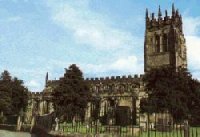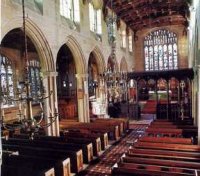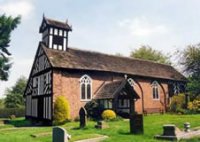 |
Back to WHAT WE DO Churches & Pubs in 2012
|
 |
10am at the village hall, unless stated otherwise.
Please inform Paul Kenneth beforehand if you wish to come on any visit. We need to provide both church & pub with an indication of numbers.
Churches and Pubs Proposed Visits for 2012
Click on the date link for the report
April 4th St.Peters, Edensor, Derbyshire. Cancelled because of snow!!!!!!
May 2nd All Saints Church, Gresford near Wrexham.
June 6th St.Giles at Great Longstone near Bakewell.
July 4th St.Nicholas, High Bradfield, S.E. of Sheffield.
Sept 5th St.Giles, Hartington, Derbyshire.
Oct 3rd All Saints Church, Siddington, Cheshire.
Nov 7th St.Peters, Hope, Derbyshire.
MAY 2
Report on the visit
On Wednesday May 2nd, thirty seven U3A members crossed from

England to Wales to visit All Saints Church in Gresford, known as ‘The finest parish church in Wales’.
The Reverend Tudor Hughes greeted us in English and Welsh to his ‘grand church’ in the Alyn Valley which serves a community of six thousand. It is one mile from the English border and services are held in English with one communion a month in Welsh.
All Saints was completed in the late 15th century but the Doomsday Book mentions a church in Gresford (Gritford) in the eleventh century. An inquisition was held on the site in 1332 and outside is the remains of a thirteenth century buttress. The yew tree near the south-east gate is over 1,600 years old.
The reason for such a large church in a small village is thought to be because it was a place of pilgrimage but it is not clear what drew the pilgrims. A sum of money was left for a velvet coat which may have been for an important statue. In fifteen hundred there were 15 priests for 100 people! There was a passage behind the altar which is thought may have been to help the procession of visitors.
The church has a bell tower and its peal is listed in a rhyme as one of the seven wonders of Wales. Four new, lighter bells have been added which have encouraged ladies and young people to ring. Eight teenagers now take part.
The three-manual organ is considered to be cathedral standard and is 100 years old this year. To maintain quiet in the church the air is pumped under the road from a house!
 The interior of the church is very light. The great east window
was given by Thomas Stanley, Earl of Derby, the step father of Henry
V11. It contains some fine glass of the fifteenth century.
Three other windows include the figure of St Appolonia holding a tooth
in a pair of pincers. She is the patron saint of dentistry and
those suffering toothache.
The interior of the church is very light. The great east window
was given by Thomas Stanley, Earl of Derby, the step father of Henry
V11. It contains some fine glass of the fifteenth century.
Three other windows include the figure of St Appolonia holding a tooth
in a pair of pincers. She is the patron saint of dentistry and
those suffering toothache. Gresford is remembered for the colliery disaster in 1934 when 266 men died. A painting commemorating this fills a semicircular recess in the Trevor chapel.
The exterior of the church includes seven windows on the north and south sides with flattened arches and hood moulds ending in carved heads of animals and above them is a string course ornamented with human faces, animals, and flowers. Thieves have stolen most of the downspouts so temporary covers are in place and modern materials will be used to replace them.
To complete the visit to Wales we retired to an enjoyable lunch at The Griffin in the nearby village of Trevalyn.
Sandy Maclean
JULY 4
Report on the visit
St. Nicholas’ Church
High Bradfield near Sheffield.
When we left High Lane it was raining. It rained all the way to High Bradfield but as soon as we arrived it stopped. We were made welcome by Rev. Alan Isacson who gave us a very interesting talk on the history of the Church and the local area. This was done outside the Church with a wonderful view across the valley, while it stayed fine. We then moved inside to have a look round the Church.
A Christian Church has stood on this site for around 900years and the present building is over 500years old. To the south lies Low Bradfield where a Saxon cross was found, indicating a Christian place of worship in the area long before the first stone-built Church in Bradfield. Until 1868 the Church of St. Nicholas, first built in 1109, was a chapel-of-ease in the large parish of Ecclesfield. Behind the Church gate stands the Watch Tower which was built, in1831, to combat body-snatchers who needed corpses for research in Sheffield’s recently founded medical schools. When you look at the roof the beams are remarkable for the 76 bosses date from the late 15th century. In the porch there are re-used sections of a medieval coffin lid showing the shaft of a Calvary cross. Inside on the south side is a slate plaque which commemorates the Sheffield flood of 1864 when the nearby Dale Dyke Dam burst and 240 people were drowned.
An unusual feature of the chancel is the sunken vestry which once provided refuge for visiting priests who might have to stay the night during inclement weather. Most of the present furniture was carved and fitted by the Sheffield wood craftsman Arthur Hayfield and his daughter Clara, in the late 19th century. After her father’s death Clara continued the carving, including the five intricate panels of the pulpit which depict Christ and the four Gospel writers with their symbols.
The medieval window contains fragments of original 15th century glass with fine examples of ‘silver staining’. It was put together during a large re-ordering of the Church in the late 19th century. The five bosses or balls on the Saxon cross are thought to represent drops of Christ’s blood similar to consecration crosses found on some stone altars. The plain Norman font is made of magnesian limestone and has a lead-lined bowl while the Tower houses a peal of eight bells.
A very enjoyable morning was followed by an excellent lunch at The Old Horns pub in the village.
Paul Kenneth.
SEPTEMBER 5Report on the visit
St. Giles, Hartington
We set off for Hartington [41 of us] on a glorious sunny day. On arrival at

the church we were met by our guide for the morning, Chris Duledge. He was probably one of the best guides we have had on Churches & Pubs. Everyone sat down in the church where Chris spent 15-20 mins telling us about the history of Hartington Village and the surrounding area. Then we had a short break for tea and coffee. He then took us outside and talked about the church porch and the outside of the church. He then gave the group a tour round the inside pointing out all the many interesting parts.
The foundations of the present structure of the church were laid in the early 13th century. The north wall of the chancel is the only part remaining of this date, but the north transept and the detached shafts at the east and west ends of the nave suggest that there was, later that century, a cruciform “Early English Church” here. The pitch of its steep roof can be seen by the groove in the east wall tower.
In the early 14th century the south transept was remade and enlarged, while later the same century, the south wall of the chancel was rebuilt. The tower also dates from that period. In the15th century the walls of the church were made higher, using the large semi-dressed blocks of sandstone which can be seen where the plaster has been removed in the nave. Later still a flat roof replaced the steep one and the unmatching clerestory windows were made. This change brought the ceiling down to the very top of the window arch in the south transept, where the original carved bosses can be seen in the cross beams. The porch, with its room above, dates from about 1450 and a little later the square windows in the north aisle and in the chancel were added, while finally in the Tudor period the north doorway, [now bricked up] and only discernable from the churchyard, ended the long years of building here in Hartington.
The north aisle pews are still known as the free seats recalling the days when only the rich had pews and the church provided benches for the poor who could not hire anything more comfortable. The old pews and benches were removed by the Victorians because most of them were rotten.
After an excellent morning at the church we wandered down the hill into the square of the village and descended on the Devonshire Arms for lunch where the food was excellent.
An excellent day for weather, church and pub. Thanks again to Chris from the church and Dale and her team from the pub.
Paul Kenneth.
OCTOBER 3
Report on the visit
All Saints, Siddington. Cheshire.
 Wonderful!
What a delight to receive such a welcome from the ‘Corn Dolly
Man’. This must rate as one of our most entertaining and
enjoyable church visits.
Wonderful!
What a delight to receive such a welcome from the ‘Corn Dolly
Man’. This must rate as one of our most entertaining and
enjoyable church visits.Our guide Raymond Rush made us laugh and smile as he spoke so enthusiastically about the church he has made his own, and decorated to perfection with corn dollies of every shape and size. We were fortunate to see the church fully decorated for harvest. It had been brought up to date with Olympic rings, 60th Jubilee and a corn dolly clock.
He explained the significance of the corn and its importance in fertility.
So much to see and hold our interest. Built in 1521 (and maybe earlier) with an original wattle and dawb and thatched roof. The roof was replaced in 1700’s and a much heavier roof installed, which is still there. The wooden pillars are made of solid oak. When it was realised that the new roof was too heavy for the walls the wattle was encased in local hand made bricks at a cost of £22-10-6d!
A recent addition in 1996 is the animal window to commemorate the annual services held each June. I could go on and on but many of us left saying we must come again. So why don’t you go too. The church is always open.
Betty Upham
NOVEMBER 7
Report on the visit
St Peter's Church, Hope, Derbyshire

A grey start to the day which gradually improved as we drove along Rushup Edge. The ridge between the Edale and Castleton valleys showed to perfection - Mam Tor, Back Tor and Lose Hill, then Win Hill in the distance looking like a witch's hat.
Hope village centre, with church, pubs, shops and cottages was bathed in sunlight. St Peter's is a gritstone church, built in perpendicular style in the 1300's (Chaucer's time). It has a tower with a broach spire and quite a long chancel.
The site goes back to the Royal Hunting Forest of Saxon times and is mentioned in the Domesday Book of 1086. They then had church, priest and six hamlets. It is assumed the present building is on the same site.
In the 16th century the roof was raised to let in more light hence the clerestory and timber roof. In 1882, the then Vicar Henry Buckston demolished the chancel interior without permission and was required to make good so he recycled the box pews in the choir stalls, put in a tiled floor, and there is some carving by the "mouseman".
The beautiful East window is a memorial and the others here are by Kempe & Son, telling the story of the Holy Week.
There are many interesting things to see, including a Breeches' Bible using one of the earliest translations from Latin and a fine pulpit from around the same time, 1887.
Above the main door on the south side is a Parvise, originally a room with a fire for the curate.
Outside are some fearsome looking gargoyles, remains of a market cross and saxon cross stump from Eccles hill top. The new roof is steel, not lead and sadly the church lost its silver during a Wakes Week robbery in 2011.
Many thanks to the former vicar and church warden for their time, and to Paul for this and all visits this year. We had a good and well organised lunch and guess what? It was still a grey day when we got home having enjoyed Peak District sunshine.
Valerie Crowther